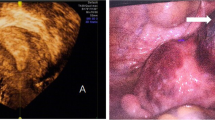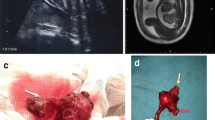Abstract
Meconium periorchitis is caused by the leakage of meconium from a bowel perforation into the peritoneal cavity via a patent processus vaginalis into the scrotal sac during fetal life or in the early postnatal period. Intrauterine meconium peritonitis causes sterile inflammatory response and calcification. Here, we describe a prenatally diagnosed case of meconium periorchitis. During the ultrasound scan at 29 weeks’ gestation, enlargement of the scrotum with many small hyperechogenic masses and normal anatomy of testis was observed. Our case is the 11th prenatally diagnosed case presented in the worldwide literature and the first one described in Poland. This case confirms the latest tendency for the conservative management of meconium periorchitis and an asymptomatic postnatal course.








Similar content being viewed by others
References
Olnick HM, Hatcher MB. Meconium peritonitis. JAMA. 1953;152:582–4.
Kimball D, Smith W. Meconium peritonitis with thoracic extension. AJR. 1985;144:113–4.
Wax JR, Pinette MG, Cartin A, et al. Prenatal sonographic diagnosis of meconium periorchitis. J Ultrasound Med. 2007;26:415–7.
Patton WL, Lutz AM, Willmann J, et al. System spread of meconium peritonitis. Pediatr Radiol. 1998;28:714–6.
Brown-Harrison MC, Harrison AM, Reid BS, et al. Meconium periorchitis: a cause of scrotal mass in newborn. Clin Pediatr (Phila). 2000;39:79–82.
Jeanty C, Bircher A, Turner C. Prenatal diagnosis of meconium periorchitis and review of the literature. J Ultrasound Med. 2009;28:1729–34.
Finkel LI, Slovis TL. Meconium periorchitis, intraperitoneal calcification and cystis fibrosis. Pediatr Radiol. 1982;12:92–3.
Cesca E, Midrio P, Tregnaghi A, et al. Meconium periorchitis: a rare cause of fetal scrotal cyst—MRI and pathologic appearance. Fetal Diagn Ther. 2009;26:38–40.
Varkonyi I, Fliegel C, Rosslein R, et al. Meconium periorchitis: case report and literature review. Eur J Pediatr Surg. 2000;10:404–7.
Kenny PJ, Spirt BA, Ellis DA, et al. Scrotal masses caused by meconium peritonitis: prenatal sonographic diagnosis. Radiology. 1985;154:362.
Sukcharoen N. Prenatal sonographic diagnosis of meconium peritonitis: a case report. J Med Assoc Thai. 1993;76:171–6.
Agrawai N, Kiplani A, Bhatla N, et al. Idiopathic origin of meconium periorchitis. Indian J Pediatr. 2000;67:845–6.
Gililland A, Carlan SJ, Greenbaum LD, et al. Undescended testicle and a meconium-filled hemiscrotum: prenatal ultrasound appearance. Ultrasound Obstet Gynecol. 2002;20:200–2.
Koh CC, Sheu JC. Intestinal atresia presenting as bilateral scrotal pneumatocele: a case report. J Pediatr Surg. 2002;37:E2.
Regev RH, Markovich O, Arnon S, et al. Meconium periorchitis: intrauterine diagnosis and neonatal outcome: case reports and review of the literature. J Perinatol. 2009;29:585–7.
Conflict of interest
None.
Ethical standards
All procedures followed were in accordance with the ethical standards of the responsible committee on human experimentation (institutional and national) and with the Helsinki Declaration of 1975, as revised in 2000(5). Informed consent was obtained from all patients for being included in the study.
Author information
Authors and Affiliations
Corresponding author
About this article
Cite this article
Stupak, A., Krzyzanowski, A., Semczuk-Sikora, A. et al. Conservative management after prenatal ultrasound diagnosis of meconium periorchitis. J Med Ultrasonics 41, 499–505 (2014). https://doi.org/10.1007/s10396-014-0538-8
Received:
Accepted:
Published:
Issue Date:
DOI: https://doi.org/10.1007/s10396-014-0538-8




